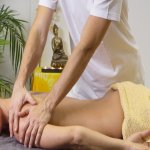The Mystery of the Romanian Orphanage
During the 1980s, large numbers of children in Romanian orphanages were suffering from severe mental and developmental disorders (1-2). These disorders occurred despite ample amounts of food, water, and shelter… so what could be the cause?
Meaney’s Rats
Meanwhile, halfway across the globe, a professor named Michael Meaney was noticing an interesting phenomenon in the rats in his research lab. After giving birth to a new litter, rat mothers would fervently lick their newborns, and if they were deprived of this opportunity, their pups would become excessively neurotic (3-5).
When Meaney examined these overly neurotic rats, he found that they displayed lower levels of oxytocin and higher levels of stress hormones such as cortisol (3-5). Could there be a connection between Meaney’s rats and the Romanian orphans?
The Power of Touch
According to research, humans are not entirely different from rats. Like Meaney’s rats, humans have been shown to increase oxytocin levels and decrease stress hormones in response to being touched (6). For example, one study found that as little as 15 minutes of massage can lead to major reductions in cortisol. (6)
Amazingly, when the Romanian orphans were provided with 20 minutes of tactile stimulation per day, these infants experienced enormous improvements in developmental milestones (7-8). Despite having access to food, water, and shelter, the orphans had been suffering from a lack of touch.
Why is Touch so Powerful?
In one study, women were exposed to painful electric shocks while in an fMRI machine (9). When women were holding their husband’s hands during the shocks, activation in the areas of the brain associated with pain showed a remarkable decrease. The mere act of touching another person can decrease our body’s sensitivity to pain (9-11).
In another study, office employees who received a 15 minute chair massage once per week enjoyed dramatic reductions in stress and anxiety (12). Amazingly, these benefits were still measurable three weeks after the intervention had ended.
Conclusions
Touch has powerful effects on the nervous and endocrine system, and can often be valuable for those who are suffering from pain.
References
1 Rutter ML, et al. Specificity and heterogeneity in children’s responses to profound institutional privation. Br J Psychiatry. 2001 Aug;179: 97-103. Retrieved from http://www.ncbi.nlm.nih.gov/pubmed/11483469
2 Frank DA, et al. Infants and young children in orphanages: one view from pediatrics and child psychiatry. Pediatrics. 1996 Apr;97(4):569-78. Retrieved from http://www.ncbi.nlm.nih.gov/pubmed/8632947/
3 Plotsky PM, Meaney MJ. Early, postnatal experience alters hypothalamic corticotropin-releasing factor (CRF) mRNA, median eminence CRF content and stress-induced release in adult rats. Brain Res Mol Brain Res. 1993 May;18(3):195-200. Retrieved from http://www.ncbi.nlm.nih.gov/pubmed/8497182
4 Champagne FA, et al. Variations in maternal care in the rat as a mediating influence for the effects of environment on development. Physiol Behav. 2003 Aug;79(3):359-71. Retrieved from http://www.ncbi.nlm.nih.gov/pubmed/12954431
5 Champagne FA, Meaney MJ. Transgenerational effects of social environment on variations in maternal care and behavioral response to novelty. Behav Neurosci. 2007 Dec;121(6):1353-63. Retrieved from http://www.ncbi.nlm.nih.gov/pubmed/18085888
6 Morhenn V, Beavin LE, Zak PJ. Massage increases oxytocin and reduces adrenocorticotropin hormone in humans. Send to:Altern Ther Health Med. 2012 Nov-Dec;18(6):11-8. Retrieved from http://www.ncbi.nlm.nih.gov/pubmed/23251939
7 Ardiel EL, Rankin CH. The importance of touch in development. Paediatr Child Health. 2010 Mar; 15(3): 153–156. Retrieved from http://www.ncbi.nlm.nih.gov/pmc/articles/PMC2865952/
8 Casler L. The effects of extra tactile stimulation on a group of institutionalized infants. Genet Psychol Monogr. 1965 Feb;71:137-75. Retrieved from http://www.ncbi.nlm.nih.gov/pubmed/14279691/
9 Coan JA, Schaefer HS, Davidson RJ. Lending a hand: social regulation of the neural response to threat. Psychol Sci. 2006 Dec;17(12):1032-9. Retrieved from http://www.ncbi.nlm.nih.gov/pubmed/17201784
10 Doehring KM. Relieving pain through touch. Adv Clin Care. 1989 Sep-Oct;4(5):32-3. Retrieved from http://www.ncbi.nlm.nih.gov/pubmed/2789636
11 Master SL, et al. A picture’s worth: partner photographs reduce experimentally induced pain. Psychol Sci. 2009 Nov;20(11):1316-8. Retrieved from http://www.ncbi.nlm.nih.gov/pubmed/19788531
12 Shulman KR, Jones GE. The effectiveness of massage therapy intervention on reducing anxiety in the workplace. J Appl Behav Sci. 1996 Jun; 32(2): 160-173. Retrieved from http://psycnet.apa.org/psycinfo/1996-04742-003
